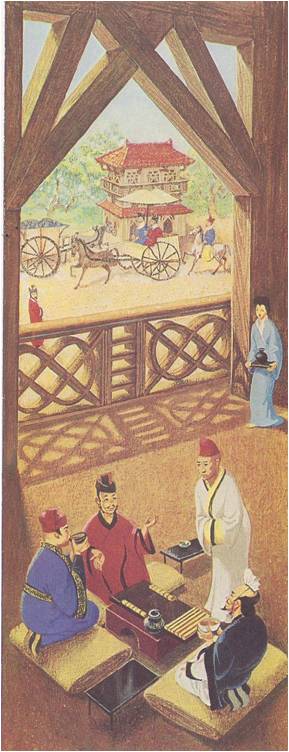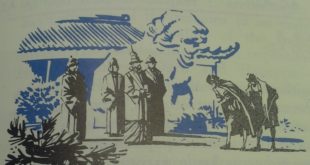THE three states into which China had split were soon split up themselves into even smaller divisions. For three and a half centuries, war raged almost continuously among rival kings. Doubt and confusion were everywhere.
The period between 220 and 589 is called the Six Dynasties era, after six ruling families in a row which used Nanking as their capital. In all those years‚ the memory of the Han Empire never died. Looking back longingly at the peace and order of that time, the people came to think of the Han government as the great model which all rulers should try to copy.
With the country divided, it was easy for the barbarians to invade. During the fourth century, wave after wave of nomads rolled south across the North China Plain, as the Huns were joined by their relatives, the Mongols and the Turks. Riding swift ponies, the invaders mowed down the Chinese foot soldiers with deadly arrows from their crossbows. Huge numbers of Chinese fled-some to Kansu in the northwest and Szechwan in the west, but many more to the lands south of the Yangtze River. The Chinese population of south China doubled, tripled and quadrupled, until it overwhelmed the non-Chinese population. Even in north China the Chinese greatly outnumbered their barbarian conquerors. Due to this and because the Chinese system of government was much better suited than theirs to a country of farmers, the newcomers gradually adopted Chinese ways.
THE SEVEN SAGES
Chinese ways were themselves changing. Just as the rebellions, wars and invasions uprooted millions of people from their settled lives on the land, so they uprooted the beliefs by which these people lived. These beliefs, Confucianism and Taoism, were mainly rules for everyday living. They had worked well enough in orderly Han times, but they no longer seemed to do so in the mixed-up conditions of the Six Dynasties era. People began to look for new answers to the old problems of life.

The Han Empire had supposedly been based on the teachings of Confucius, its fall was a serious blow to Confucianism. Many Confucians became Taoists. Taoism had become very different from the early teachings of Lao-Tse, its founder. The difference was clear to everyone in the rebellions which swept the country toward the end of the Later Han period. The rebels were ardent Taoists, who believed they could make miracles happen by faith. In the Yellow Turbans and the Five-Pecks-of-Rice Band, Taoism became the first organized religion China had ever known.
When Han authority broke down, Taoism Spread to the upper classes, too. A group of educated men formed a Taoist movement called ch’ing-t’an‚ meaning “pure discussions.” Their answer to the serious problems of the time was to ignore them and act as they pleased. The best known philosophers of this school were called the Seven Sages of the Bamboo Grove. These wealthy truth-seekers lived together outside the city of Loyang, discussing philosophy, writing poems, playing music, taking strolls and drinking. One sage expressed his own philosophy by having a servant follow him around with a bottle and a shovel. The bottle was to quench his thirst if he felt dry and the shovel to bury him with if he dropped dead.
BUDDHISM SWEEPS CHINA
More and more, Taoism borrowed its practices from Buddhism. It is not surprising that Confucians turned to Taoism in the troubled Six Dynasties era, but it is surprising that Buddhism finally became the most popular faith in China. It was far different from the Chinese philosophies. Both Confucianism and Taoism dealt with the problems of living people and neither had much to say about such matters as life after death. Buddhism, on the other hand, was deeply spiritual. It taught that life was painful and that men should seek relief from pain through prayer and meditation. Its goal was not contentment but a state of blissful non-existence called nirvana.
Buddhism did not drive out the Chinese philosophies, however. For even though it was different from them in spirit, its teachings did not necessarily conflict with theirs. A man could be both a Buddhist and a Taoist, or both a Buddhist and a Confucian. Some people, in fact, managed to be all three at once.
From the fourth century on into the eighth, Buddhist ideas dominated Chinese life and civilization. They influenced the way people thought about all sorts of things, from private matters‚ such as how to treat a headache, to questions of public interest, such as the people’ s duties toward their ruler and his duties toward them. Buddhist ideas decided the subjects of books and paintings. Their influence on sculpture was particularly noticeable, as statues of the Buddha sitting cross-legged at his meditations rose throughout the land.





